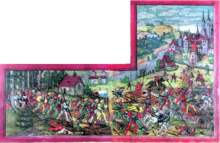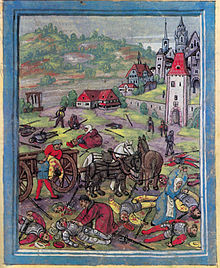Battle in the Schwaderloh
| date | April 11, 1499 |
|---|---|
| place | Triboltingen in the canton of Thurgau , Switzerland |
| output | Victory of the Confederation |
| Parties to the conflict | |
|---|---|
|
Old Confederation :
Bern Lucerne Freiburg
and Common rule Thurgau |
|
| Commander | |
|
Rudolf Has and Sub-Commander-in-Chief |
|
| Troop strength | |
| 6000–7000 Swabian knights and mercenaries | approx. 1500 people from Lucerne, Thurgau, Bern, Freiburg |
| losses | |
|
1,300–2,000 dead |
approx. 100 dead |
Triesen · Hard · Bruderholz · Hallau · Schwaderloh · Frastanz · Calven · Dornach
The battle in Schwaderloh was fought on April 11, 1499 during the Swabian War between troops of the Swabian Federation and the Swiss Confederation . The name, which is particularly widespread in Swiss history, is derived from the camp of the federal troops near the hamlet of Schwaderloh , which is about four kilometers south of the city of Constance . With the "Schwaderloh" 1499 and also in the Swiss Federal Chronicle of the 16th century, however, not the hamlet, but a broader area in front of Constance with the ridge of the Tägerwiler forest and south of it. The actual battlefield is near Triboltingen , which is why the term “battle near Triboltingen” has recently been used.
prehistory
In December 1498 Konstanz became a member of the Swabian Confederation, which in 1499 was drawn into the Swabian or Swiss War with the Swiss Confederation . Since Constance lies on the left bank of the Rhine and thus offered an ideal gateway into the federally ruled Thurgau , the military commanders of the Swabian Confederation brought together a large number of troops in the city in April 1499. Well-developed access roads enabled artillery and supplies of all kinds to be brought in.
The Swabian parade was not hidden from the Swiss Federal Diet . As early as January, therefore, guards (so-called attachments) were placed in the Schwaderloh to watch the enemy movements. However, according to the captains' complaints, the contingent was clearly too small, which is why repeated requests for reinforcements were made. The locations of these teams, which mainly consisted of Thurgau, were among others Schwaderloh, Alterswilen and Dotnacht . Several hundred Thurgauers camped in Scherzingen near the shore of Lake Constance. At the Untersee near Ermatingen and Mannenbach there were about 500 men in addition, besides Thurgauers also Bernese, Freiburg and Lucerne servants. The Ermating garrison was irritated almost daily by attacks from Konstanz and Gottlieben and was exposed to artillery fire from the island of Reichenau . On April 11, 1499 there were about 1,500 men on the federal side in Schwaderloh, of which about 600 were from Thurgau.
The battle

In the early morning hours of 11 April marched from 6000 to 7000 Swabian mercenaries from Constance and to the at Ermatingen positioned Federal Department of attack. However, a simultaneous attack with boats from the island of Reichenau did not bring the desired surprise effect, so that the attacked could prepare in time. The Confederates threw themselves at the attackers, since they only suspected a minor attack, but had to retreat to the nearby forests because of the great superiority. They lost around 80 men and had to leave behind the two Lucerne artillery pieces that had been brought to Ermatingen to bombard the Reichenau.
The Swabian troops occupied the villages of Ermatingen, Triboltingen and Mannenbach and began to plunder. Apparently the commanders' goal for the day had already been achieved. In the meantime, the federal contingent of Ermatingen united with the concentrated forces at Schwaderloh. It was decided, despite the inferiority, to attack the Swabian troops before they could bring their booty to safety in Constance. Together with another Thurgau contingent of around 400 men who arrived from Scherzingen , around 1,800 confederates moved directly through the forest between Schwaderloh and Triboltingen down to the plain on the Untersee.
When the Swabian troops made their way back towards Constance and some wine and cider had already been drunk, the Confederates attacked surprisingly. The chronicler Niklaus Schradin reports in his rhyming chronicle of the Swabian War (1500) that the confederates pushed out of the forest down the slope to Triboltingen with great noise, whistling and drumming. The Swabian troops were able to form a few pieces of artillery for battle just in time under the protection of the cavalry. According to contemporary information, the Swabian artillery fired at the advancing Confederates, but aimed too high. The smoke that developed in the process enabled the Confederates to approach the clouded Swabian battle formation unseen and to overrun them with the force of the spies.
When the Swabian order of battle dissolved and the infantry began to flee, the federal formation split up. The spear bearers fought the Swabian knights on horseback, while the halberdiers and swordsmen chased the fugitives. The persecution reached as far as the walls of Gottlieben, the Tägermoos and the walls of Konstanz. Numerous Swabian farmhands were pushed into Lake Constance and had to leave all their armor and belongings on the shore in order to swim to safety or to be picked up by boats. Most of the between 1,300 and 2,000 men who were lost on the Swabian side probably drowned in the swamps or in the lake. Then there was the cruel warfare of the Confederates. According to the decision of the Diet of March 11th, no prisoners were allowed to be taken in this war; moreover, they made the troops swear by them. Anyone who was left injured was cut down. The 130 or so dead from Konstanz were rescued after the battle, the remaining 1,000 or more were left lying on the battlefield, stripped of their equipment and clothes. The confederates' booty was considerable: the entire artillery of the Swabian federal troops, numerous standards, a large pile of weapons, armor, the baggage train and the booty from the looting in and around Ermatingen fell into their hands.
The federal victory caused a considerable weakening of the troops of the Swabian Federation in Constance and until July 1499 prevented any efforts to cause a serious failure in Thurgau or to disrupt the federal trains in Hegau and Klettgau .
literature
- Hans Rudolf Kurz: Swiss battles . Second, revised and expanded edition. Francke, Bern 1977, ISBN 3-7720-1369-4 , pp. 165-171.
- Hugo Schneider, The Battle of Schwaderloh, for the 450th Memorial Day 1499–1949. Published by the Thurgau officers' society. Bodan Verlag, Kreuzlingen 1949.
- Bruno Meyer: The Thurgau in the Swabian War of 1499. In: Thurgau contributions to patriotic history. Vol. 134, 1979, pp. 5-219, therein pp. 45-63.
- Contemporary reports on the battle in Schwaderloh summarized in detail in: Hermann Wiesflecker u. a. (Ed.): Regesta Imperii , XIV: Selected Regesta of the Empire under Maximilian I 1493–1519. Volume 3, Part 2: Austria, Empire and Europe 1499–1501. Böhlau, Vienna / Cologne / Weimar 1998 (online: No. 13132 , No. 13133 , No. 13134 , No. 13135 , No. 13146 ).
Web links
Individual evidence
- ^ Ralf Seuffert: Constance. 2000 years of history. UVK Verlagsgesellschaft, Konstanz, 2nd edition 2013, pp. 68–69.

